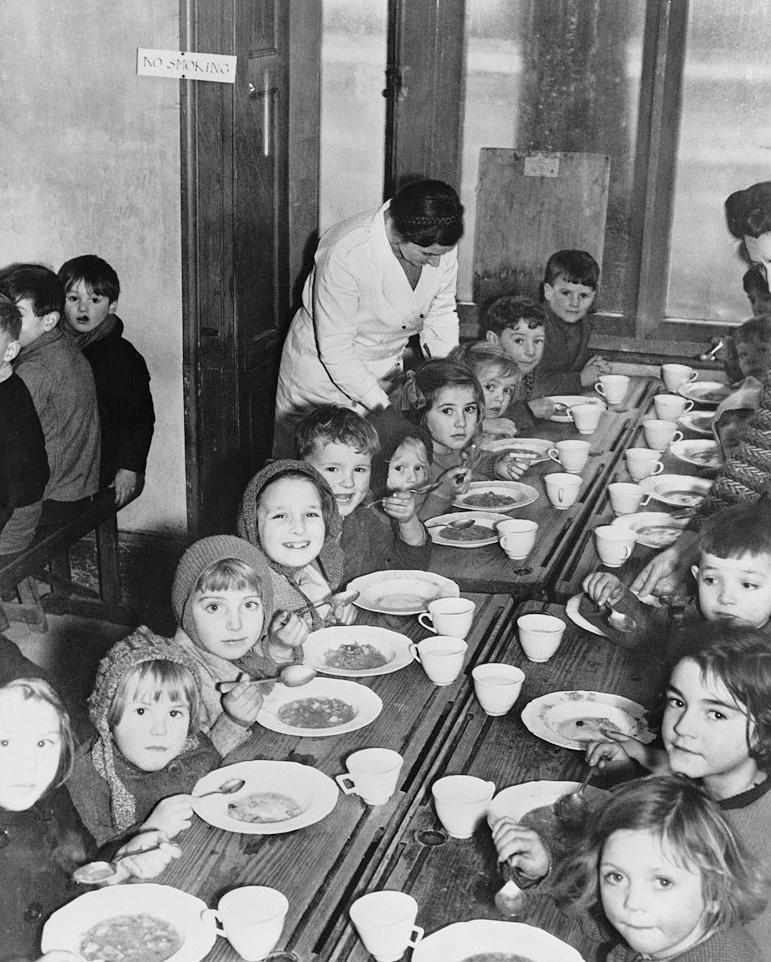
World War II: American European Relief Effort -- Britain

Figure 1.--Britain evacuated latge numbers of children from London and other major cities, but it was not a mandtory evcuation. Many children remained in he cities. Some parents could not begin to part with their children. And after the firsr=t evcuatioin in 1939, many children resisted a second evacuation and bing parted from their parenys in 1940. Here evacuees from Londonís hard hit East End are 'tucking into' vegetables soup. The vegetables came from America. They were dehydrated for economical shipment across the Atlantic to provide nourishment to children on Britainís home front. The photograph was taken December 1941. Source: British Ministry of War
|
|
Food for Britin was not a matter of just humanitarian relief. It was necessary to keep a vital fighting ally in the War. Britain like Germany was not self suffient in food. Britain was an industrialized nation and its manufacured exports paid for food and raw material imports. It had a 3,000-strong merchant feet to move its exports and imports. Some 10-15 merchant ships on average arrived in British ports every day . They brought 68 million tns of imports annually, about one-third of which was foodsome 22 million tons. [Collingham, p. 67.] This was a vulnerability that the Germans attempted to attack with a commerce war, mostly by U-boats, in both World Wars. But the U-boats were not the only problem britain faced. German victories on the Continent cut Britain off fron European sources. Bacon, butter and cheese had come from the Netherlands and Denmark. Onions had come from Spain, France, and the Channel Islands. Another problem was that tropical fruits, sugar, and beef had come from distant locations. And fruits like orange were very bulky for the food value contained requiring much more dhipping per alorie than oher food stuffs. And war required more shipping than normal times. In additions ships were being sunk. Thus Britain had to priortize. Ships carring food had to make the shirtest runs possible to maximize the quanity of food that could be delivered. And this meant primarily the North Atlantic run from America and Canada. Another problem was paying for the food. The need for the food continued, but with British industry mobilized for war, they were no longer exporting manufctured goods earning foreign exchange. After little more than a year, Primeminister Churchill had to inform President Roosevelt that Britain was bankrupt (December 1940). The President's answer was Lend Lease which would play a major role in feeding Britain during the war. The Allies also abandoned the free market. After Pearl Harbor (December 1941), Churchill arrived in Washington. The Arcadia Conference resulted in several planning boards. One of these was the Combined Food Board which would attempt to coordinate food producrion and distribtion in the areas controlled by the Allies.
Sources
Collingham, Lizzie. The Taste of War: World War II and the Battle for Food (Penguin Books: New York, 1962), 634p.
CIH -- WW II

Navigate the CIH World War II Pages:
[Return to Main American World War II Relief Effort individal European country page]
[Return to Main American World War II Relief Effort individal country page]
[Return to Main American World War II Relief Effort country page]
[Return to Main American World War II Relief Effort page]
[Return to Main Children and food in World War II page]
[Return to Main Children in World War II page]
[Return to Main war and children page]
[Biographies]
[Campaigns]
[Children]
[Countries]
[Deciding factors]
[Diplomacy]
[Geo-political crisis]
[Economics]
[Home front]
[Intelligence]
[POWs]
[Resistance]
[Race]
[Refugees]
[Technology]
[Bibliographies]
[Contributions]
[FAQs]
[Images]
[Links]
[Registration]
[Tools]
[Return to Main World War II page]
[Return to Main war essay page]
Created: 8:57 AM 7/17/2017
Last updated: 8:57 AM 7/17/2017



